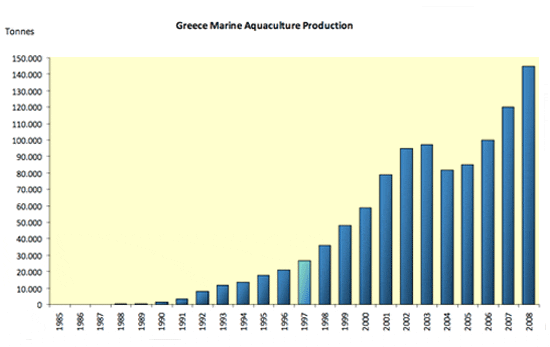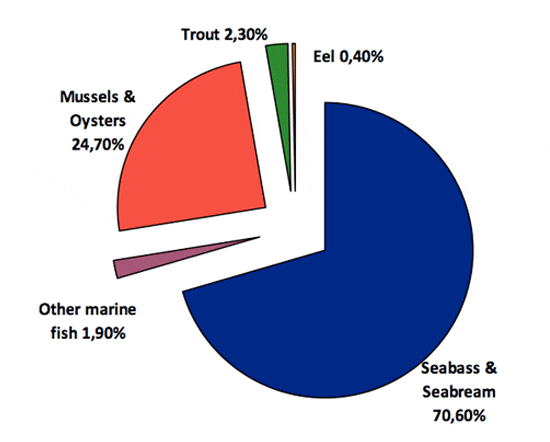Overview of main producing countries
Large and/or organized industry
GreeceThe first modern marine aquaculture company in Greece was founded in 1981 and from an initial annual production of 90 tonnes in 1985, the industry has grown an impressive 47 per cent annually on average to a production of 145 000 tonnes in 2008. Measured from its more mature stage, 1995 to 2008, the industry has enjoyed a 17 per cent average annual growth rate. The industry has undoubtedly benefited from the natural advantages of its geography, a long coastline with many sheltered bays, favourable climatic conditions and national and EU subsidies for investment in production infrastructure.
Figure 6 – Greece: Marine aquaculture production, 1985–2008

Greece is by far the largest producing country for European seabass and gilthead seabream in the Mediterranean with 2008 production reaching 145 000 tonnes according to some estimates. This would account for 48 per cent of total estimated production for 2008 of 300 000 tonnes. There is however a very large discrepancy between official figures and actual or estimated figures. The latest published data by the Ministry of Rural Development and Food (MRDF) states that in 2005 total aquaculture production, including fish, bivalves and shellfish combined, amounted to 105 000 tonnes of which marine fish amounted to 75 000 tonnes. Assuming that production of all other species is not also under-stated, total Greek aquaculture production should have been around 175 000 tonnes in 2008. It is estimated that the European seabass and gilthead seabream production sector employs close to 10 000 people directly on a full-time basis. According to 2005 MRDF figures the second largest sector in Greece is the production of mussels and oysters, at 24.7 per cent of the total, followed by trout, other marine fish and eels.
Figure 7 – Greece: Aquaculture production by main species groups, 2007

There are 383 licences for on growing units of European seabass, gilthead seabream and “new species for aquaculture” for a combined official licensing capacity of 90 060 tonnes. The “new species for aquaculture” licences are for the most part used to produce European seabass and gilthead seabream and legislation has been adopted recently to rename all licences as being for the production of “Mediterranean species”. Currently operating licences are estimated at 328. There are 59 hatchery licences with 39 hatcheries operating in 2009 with an official capacity of 180.1 million European seabass and gilthead seabream and 127.3 million of “new species for aquaculture”. Estimated actual production, however, is much higher at 465 million of European seabass and gilthead seabream for 2007. This segment is even more concentrated than the on growing production sector with three companies accounting for close to 90 per cent of total production. Most juveniles production is used nationally except for some quantities exported to subsidiary or affiliated companies in Turkey and Spain.
There are 189 companies operating in the sector but the industry has become highly concentrated over the past ten years with six companies controlling 60 per cent of national production and 16 companies or group of companies controlling between 70–75 per cent of production. The industry in Greece is vertically integrated, with the 16 largest companies owning their own hatchery production facilities and the three largest companies owning their own feed production plants (representing about 60 per cent of feed production in Greece) and processing plants. In recent years there has been some expansion of Greek companies into other countries, namely Turkey and Spain, through the outright purchase or part participation in the shareholding of Turkish and Spanish companies. Expansion into Turkey was motivated by a perceived lower cost of production combined with the direct export subsidy afforded to Turkish production. Investment into Spanish production was motivated by the advantage of a national supplier in one of the largest consuming markets for European seabass and gilthead seabream in Europe.

